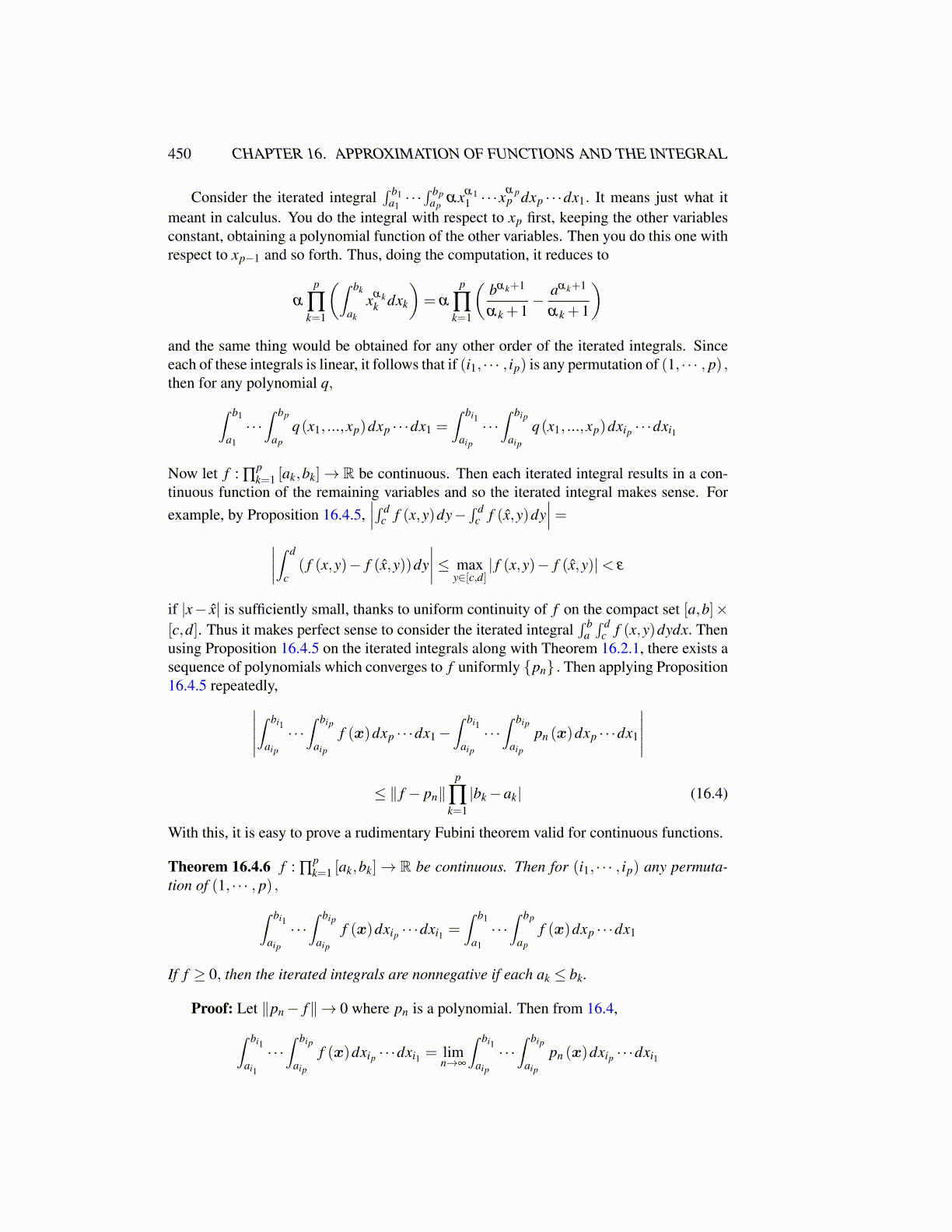
450 CHAPTER 16. APPROXIMATION OF FUNCTIONS AND THE INTEGRAL
Consider the iterated integral∫ b1
a1· · ·∫ bp
apαxα1
1 · · ·xα pp dxp · · ·dx1. It means just what it
meant in calculus. You do the integral with respect to xp first, keeping the other variablesconstant, obtaining a polynomial function of the other variables. Then you do this one withrespect to xp−1 and so forth. Thus, doing the computation, it reduces to
α
p
∏k=1
(∫ bk
ak
xαkk dxk
)= α
p
∏k=1
(bαk+1
αk +1− aαk+1
αk +1
)and the same thing would be obtained for any other order of the iterated integrals. Sinceeach of these integrals is linear, it follows that if (i1, · · · , ip) is any permutation of (1, · · · , p) ,then for any polynomial q,∫ b1
a1
· · ·∫ bp
ap
q(x1, ...,xp)dxp · · ·dx1 =∫ bi1
aip
· · ·∫ bip
aip
q(x1, ...,xp)dxip · · ·dxi1
Now let f : ∏pk=1 [ak,bk]→ R be continuous. Then each iterated integral results in a con-
tinuous function of the remaining variables and so the iterated integral makes sense. Forexample, by Proposition 16.4.5,
∣∣∣∫ dc f (x,y)dy−
∫ dc f (x̂,y)dy
∣∣∣=∣∣∣∣∫ d
c( f (x,y)− f (x̂,y))dy
∣∣∣∣≤ maxy∈[c,d]
| f (x,y)− f (x̂,y)|< ε
if |x− x̂| is sufficiently small, thanks to uniform continuity of f on the compact set [a,b]×[c,d]. Thus it makes perfect sense to consider the iterated integral
∫ ba∫ d
c f (x,y)dydx. Thenusing Proposition 16.4.5 on the iterated integrals along with Theorem 16.2.1, there exists asequence of polynomials which converges to f uniformly {pn} . Then applying Proposition16.4.5 repeatedly,∣∣∣∣∣
∫ bi1
aip
· · ·∫ bip
aip
f (x)dxp · · ·dx1−∫ bi1
aip
· · ·∫ bip
aip
pn (x)dxp · · ·dx1
∣∣∣∣∣≤ ∥ f − pn∥
p
∏k=1|bk−ak| (16.4)
With this, it is easy to prove a rudimentary Fubini theorem valid for continuous functions.
Theorem 16.4.6 f : ∏pk=1 [ak,bk]→ R be continuous. Then for (i1, · · · , ip) any permuta-
tion of (1, · · · , p) ,∫ bi1
aip
· · ·∫ bip
aip
f (x)dxip · · ·dxi1 =∫ b1
a1
· · ·∫ bp
ap
f (x)dxp · · ·dx1
If f ≥ 0, then the iterated integrals are nonnegative if each ak ≤ bk.
Proof: Let ∥pn− f∥→ 0 where pn is a polynomial. Then from 16.4,∫ bi1
ai1
· · ·∫ bip
aip
f (x)dxip · · ·dxi1 = limn→∞
∫ bi1
aip
· · ·∫ bip
aip
pn (x)dxip · · ·dxi1